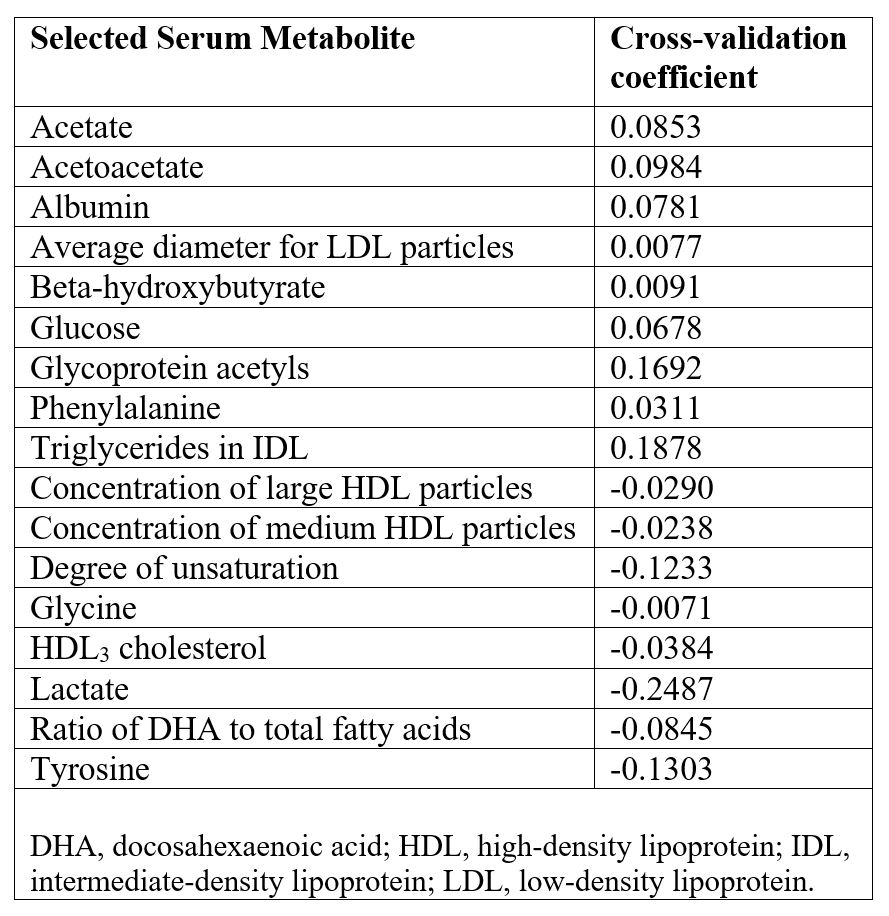Session Information
Date: Friday, November 6, 2020
Session Type: Abstract Session
Session Time: 5:00PM-5:50PM
Background/Purpose: Psoriatic arthritis and psoriasis, collectively termed psoriatic disease (PsD), are associated with increased cardiovascular (CV) risk. Metabolites comprise biomarkers that may add predictive value over traditional CV risk factors. We aimed to identify metabolites associated with CV events (CVEs) and to determine whether they could improve CV risk prediction beyond traditional CV risk factors.
Methods: Patients from a longitudinal PsD cohort without a prior history of CVEs were included. In the first available serum sample, a targeted nuclear magnetic resonance (NMR) metabolomics platform was used to quantify 64 metabolite measures comprised of lipoprotein subclasses, fatty acids, glycolysis precursors, ketone bodies and amino acids. The study outcome included any of the following CVEs occurring within the first 10 years of biomarker assessment: angina, myocardial infarction, congestive heart failure, transient ischemic attack, cerebrovascular accident, revascularization procedures and CV death. The association of each metabolite with incident CVEs were analyzed separately using Cox proportional hazards regression models first adjusted for age and sex, and subsequently for traditional CV risk factors. Variable selection was performed using penalization with boosting after adjusting for age and sex. The added predictive value of the selected metabolites to improve risk prediction beyond traditional CV risk factors was assessed using the area under the receiver operator characteristic curve (AUC).
Results: A total of 977 patients with PsD, followed between 2005 and 2019, were analyzed (mean age 49.1 ± 12.6 years, 45.1% female). During a mean follow-up of 7.1 years, 70 (7.2%) patients developed incident CVEs. In Cox regression models adjusted for CV risk factors, alanine, tyrosine, lactate, degree of unsaturation, high-density lipoprotein (HDL) cholesterol, and medium and large HDL particles were significantly associated with decreased CV risk. Acetate, glycoprotein acetyls, apolipoprotein B, remnant cholesterol, very low-density lipoprotein (VLDL) cholesterol, and very small VLDL particles were associated with an increased CV risk (Figure 1). In proportional sub-distribution hazards regression models adjusted for age and sex, 17 metabolites were selected (Table 1). The age- and sex-adjusted expanded model (base model + 17 metabolites) significantly improved prediction of CVEs beyond the base model (only age and sex) with an AUC of 79.6 vs. 72.6, respectively (p=0.038) (Figure 2).
Conclusion: Using NMR metabolomics profiling, we identified a variety of metabolites associated with a lower and higher risk of developing CVEs in patients with PsD. Further study of their underlying association with CVEs is needed to clarify the clinical utility of these biomarkers to guide CV risk assessment in this population.
 Figure 1. Metabolite associations with future cardiovascular events in patients with psoriatic disease. Hazard ratios of 64 metabolite measures with incident CV events during follow-up (n=977, 70 events). Hazard ratios are per 1-SD log-transformed metabolite concentration, adjusted first for age and sex, and subsequently in another model for CV risk factors that included age, sex, smoking, diabetes, hypertension and body mass index. Error bars denote 95% confidence intervals. *P < 0.05 (in age and sex-adjusted model only). **P < 0.05 (in both models adjusted for age and sex, and CV risk factors. †P < 0.05 (in model adjusted for CV risk factors only). C indicates cholesterol; CI, confidence interval; CV, cardiovascular; DHA, docosahexaenoic acid; HR, hazard ratio; HDL, high-density lipoprotein; IDL, intermediate-density lipoprotein; LDL, low-density lipoprotein; MUFA, monounsaturated fatty acids; PUFA, polyunsaturated fatty acids; SD, standard deviation; and VLDL, very low-density lipoprotein.
Figure 1. Metabolite associations with future cardiovascular events in patients with psoriatic disease. Hazard ratios of 64 metabolite measures with incident CV events during follow-up (n=977, 70 events). Hazard ratios are per 1-SD log-transformed metabolite concentration, adjusted first for age and sex, and subsequently in another model for CV risk factors that included age, sex, smoking, diabetes, hypertension and body mass index. Error bars denote 95% confidence intervals. *P < 0.05 (in age and sex-adjusted model only). **P < 0.05 (in both models adjusted for age and sex, and CV risk factors. †P < 0.05 (in model adjusted for CV risk factors only). C indicates cholesterol; CI, confidence interval; CV, cardiovascular; DHA, docosahexaenoic acid; HR, hazard ratio; HDL, high-density lipoprotein; IDL, intermediate-density lipoprotein; LDL, low-density lipoprotein; MUFA, monounsaturated fatty acids; PUFA, polyunsaturated fatty acids; SD, standard deviation; and VLDL, very low-density lipoprotein.
 Table 1. Selected serum metabolites associated with incident cardiovascular events, based on 5-fold cross-validation and a proportional subdistribution hazard model adjusted for age and sex.
Table 1. Selected serum metabolites associated with incident cardiovascular events, based on 5-fold cross-validation and a proportional subdistribution hazard model adjusted for age and sex.
 Figure 2. Comparison of the predictive performance of the base model (age and sex alone) and expanded model (age and sex plus selected metabolites) for prediction of cardiovascular events in patients with psoriatic disease. AUC indicates area under the receiver operator characteristic curve; CV, cross-validation.
Figure 2. Comparison of the predictive performance of the base model (age and sex alone) and expanded model (age and sex plus selected metabolites) for prediction of cardiovascular events in patients with psoriatic disease. AUC indicates area under the receiver operator characteristic curve; CV, cross-validation.
To cite this abstract in AMA style:
Colaco K, Lee K, Akhtari S, Winer R, Welsh P, Sattar N, McInnes I, Chandran V, Harvey P, Cook R, Gladman D, Piguet V, Eder L. Targeted Metabolomic Profiling and Prediction of Cardiovascular Events: A Prospective Study of Patients with Psoriatic Arthritis and Psoriasis [abstract]. Arthritis Rheumatol. 2020; 72 (suppl 10). https://acrabstracts.org/abstract/targeted-metabolomic-profiling-and-prediction-of-cardiovascular-events-a-prospective-study-of-patients-with-psoriatic-arthritis-and-psoriasis/. Accessed .« Back to ACR Convergence 2020
ACR Meeting Abstracts - https://acrabstracts.org/abstract/targeted-metabolomic-profiling-and-prediction-of-cardiovascular-events-a-prospective-study-of-patients-with-psoriatic-arthritis-and-psoriasis/
